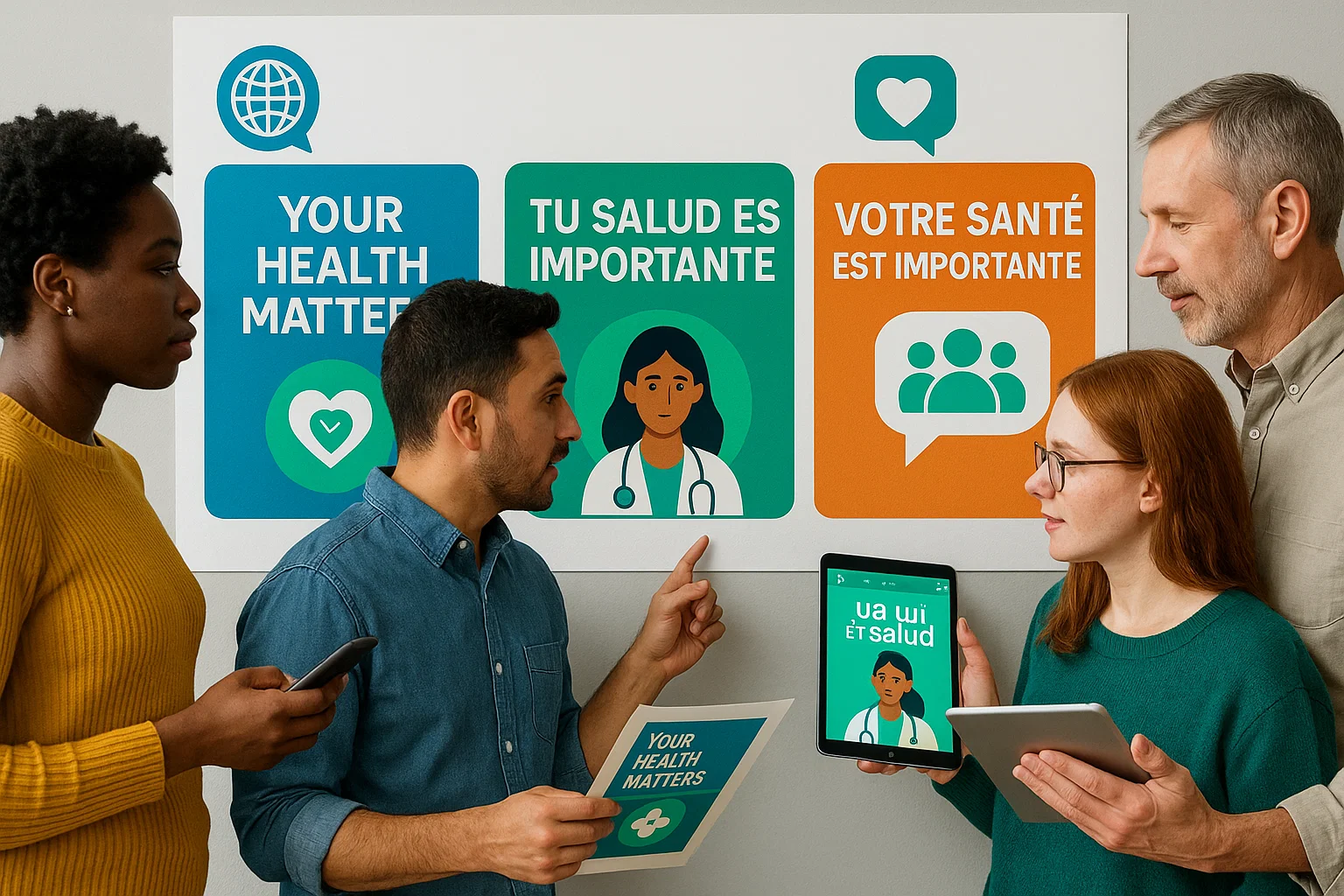The healthcare marketing landscape is undergoing unprecedented transformation in 2025. With the AI in healthcare market projected to reach $36.96 billion in 2025 and the global telehealth market expected to reach $151.08 billion, healthcare marketing executives face both extraordinary opportunities and complex challenges.
For CMOs, VPs of Marketing, and directors navigating this evolving terrain, understanding emerging trends is no longer optional—it’s essential for competitive survival. Over two-thirds of US consumers report healthcare costs as a financial burden, creating a more discerning patient population that demands transparency, value, and exceptional experiences.
This comprehensive analysis examines fifteen critical healthcare marketing trends shaping 2025, providing actionable insights for healthcare organizations seeking to enhance patient engagement, improve ROI, and establish market leadership in an increasingly competitive environment.
1. AI-Powered Marketing Transforms Patient Engagement
The AI Revolution in Healthcare Marketing
Artificial intelligence has evolved from experimental technology to essential infrastructure for healthcare marketing operations. A major study by 451 Research showed that Healthcare and Life Science organizations have on average 10 more AI models in production than organizations in other sectors, with 93% of healthcare companies planning to spend more on AI in 2025.
Strategic AI Applications for Marketing Leaders
Predictive Patient Analytics: AI algorithms analyze patient behavior patterns, demographic data, and engagement history to predict healthcare needs before patients recognize symptoms themselves. This proactive approach enables targeted healthcare marketing campaigns that reach patients at optimal decision-making moments.
Personalized Content Generation: AI-powered platforms create customized content variations for different patient segments, optimizing messaging based on demographics, health conditions, and engagement preferences. This level of personalization was previously impossible at scale but now represents table stakes for competitive healthcare marketing.
Automated Campaign Optimization: Machine learning algorithms continuously test and refine marketing campaigns, adjusting messaging, channels, and timing based on real-time performance data. This automation reduces campaign optimization cycles from weeks to hours.
Sentiment Analysis and Reputation Management: AI-powered sentiment analysis identifies trends and improvement opportunities in patient feedback, enabling healthcare organizations to address concerns proactively and enhance patient satisfaction scores.
Implementation Considerations
Healthcare marketing leaders implementing AI solutions should prioritize HIPAA-compliant platforms, invest in staff training, and establish clear governance frameworks. The technology should augment human expertise rather than replace the empathy and nuanced understanding essential to healthcare communication.
2. Telehealth Marketing Reaches Maturity
Market Growth and Patient Adoption
The global telehealth market is projected to reach $455.27 billion by 2030, growing at a CAGR of 24.68%. This explosive growth creates substantial opportunities for healthcare marketers who can effectively communicate telehealth value propositions.
The telehealth market is projected to reach $286.22 billion by 2030, representing a cornerstone of modern healthcare delivery. Healthcare organizations must now market telehealth not as an alternative to in-person care but as a preferred option for specific use cases.
Marketing Strategies for Telehealth Services
Convenience-Focused Messaging: Marketing campaigns should emphasize accessibility, reduced wait times, and elimination of travel requirements. Digital healthcare marketing strategies must highlight how telehealth fits seamlessly into patients’ busy lives.
Quality Assurance Communication: Address common concerns about telehealth quality by showcasing clinical outcomes, board-certified physicians, and technology capabilities that enable thorough remote evaluations.
Use Case Education: Develop educational content marketing that helps patients understand which conditions are appropriate for telehealth consultations versus in-person visits.
Technology Accessibility: Create marketing materials that demonstrate platform ease-of-use, particularly for older patient populations who may have technology concerns.
3. Privacy-First Marketing in a Data-Sensitive Environment
Regulatory Compliance as Competitive Advantage
Data privacy is a top concern, especially in healthcare, with marketing campaigns needing to balance personalization with compliance. Healthcare organizations that demonstrate exceptional data stewardship gain significant competitive advantages in patient trust.
Strategic Privacy Approaches
Transparent Data Practices: Clearly communicate how patient data is collected, used, and protected. Privacy-compliant marketing strategies should be prominently featured in patient communications.
First-Party Data Strategies: Customer data platforms (CDPs) such as healthcare privacy platform Freshpaint give access to critical data on how patients interact with your brand, enabling personalization without third-party data dependency.
HIPAA-Compliant Analytics: While healthcare providers are interested in understanding web visitor behavior, Google Analytics 4 and many other analytics tools are not HIPAA compliant. Healthcare marketers must invest in specialized, compliant analytics platforms.
4. Personalization at Scale Through Advanced Segmentation
Beyond Basic Demographics
The marketing trend of increasing personalization is a powerful way to combat the feeling patients have of being cogs in a big machine. However, there are more privacy concerns in healthcare than in industries like retail, with strong privacy laws protecting patient data.
Effective Personalization Strategies
Health Journey-Based Segmentation: Create patient journey maps that segment patients based on their position in specific healthcare journeys—from symptom research through treatment and recovery.
Behavioral Targeting: Analyze website behavior, content engagement, and appointment patterns to deliver relevant content that addresses specific patient needs without violating privacy regulations.
Psychographic Profiling: Use third-party data through resources like Liveramp to gather insights into consumer preferences, behaviors, and psychographics to build patient personas.
Chronic Condition Management: Develop specialized marketing campaigns for patients with chronic conditions, providing ongoing education, treatment updates, and support resources that demonstrate long-term partnership.
5. Patient Experience as Marketing Differentiator
Experience-Driven Patient Loyalty
According to Tebra’s 5th annual Patient Perspectives report, 47% of patients have left practices due to poor experiences, while 61% remain loyal thanks to excellent care. Patient experience has evolved from operational concern to critical marketing differentiator.
Marketing Patient Experience Excellence
Digital Convenience Features: The report found that 92% of patients prefer digital intake forms, and 91% expect responses to portal messages within 24 hours. Marketing communications should highlight these convenience features as core value propositions.
Experience-Focused Content: Create patient testimonial campaigns that showcase actual patient experiences, emphasizing both clinical outcomes and interpersonal care quality.
Seamless Omnichannel Experiences: An integrated approach across multiple channels ensures a consistent and seamless patient experience, with marketing efforts coordinated across digital, traditional, and in-person touchpoints.
6. Local SEO Dominance for Healthcare Providers
Location as Primary Decision Factor
Practice location is a deciding factor in choosing a healthcare provider for 59% of patients, making local search optimization critical for healthcare marketing success.
Advanced Local SEO Strategies
Google Business Profile Optimization: Maintain complete, accurate profiles with regular updates, high-quality images, and consistent NAM (Name, Address, Phone) information across all directories.
Location-Based Content Development: Create localized content strategies that address community-specific health concerns, local events, and regional healthcare trends.
Schema Markup Implementation: Use schema markup to provide clear information about your practice, staff, services, and conditions treated to help search engines understand your content and display it accurately in rich snippets.
Review Generation Systems: Encourage satisfied patients to leave reviews on platforms like Google and Yelp, highlighting these testimonials on your website and social media to build trust and attract new patients.
7. Value-Based Care Messaging and Outcomes Marketing
Shifting from Volume to Value
As healthcare payment models continue transitioning toward value-based care, marketing messaging must evolve from service promotion to outcome demonstration. Healthcare organizations must communicate how they deliver superior value through value-based healthcare marketing strategies.
Outcome-Focused Marketing Approaches
Clinical Outcome Transparency: Share measurable outcomes data, patient satisfaction scores, and quality metrics that differentiate your organization from competitors. Transparency builds credibility.
Total Cost of Care Communication: Help patients understand true healthcare costs, including long-term outcomes and prevention benefits, rather than focusing solely on episodic treatment pricing.
Prevention and Wellness Programs: Market preventive care programs that demonstrate commitment to long-term patient health rather than reactive treatment approaches.
Population Health Initiatives: Showcase community health improvement efforts that demonstrate organizational commitment beyond individual patient care.
8. Strategic Brand Partnerships and Collaborations
The Partnership Paradigm
The landmark partnership between Amazon One Medical and Cleveland Clinic signals more than just another business collaboration—it represents a fundamental shift in how healthcare services can be delivered and marketed.
Partnership Marketing Strategies
Complementary Capability Messaging: Brand partnerships in healthcare create unique value propositions that neither organization could achieve alone. Marketing should emphasize how partnerships deliver enhanced patient value.
Co-Branding Campaigns: Develop strategic healthcare partnerships that leverage both organizations’ marketing reach and brand equity.
Technology Collaboration Communication: Partner with technology companies to enhance digital capabilities while maintaining focus on clinical expertise and patient care quality.
9. Content Marketing Evolution: Educational Authority Building
From Promotion to Education
Educational content is vital in building trust and authority, with blogs, webinars, and video content that provide valuable health information attracting and retaining patients.
Advanced Content Strategies
Condition-Specific Content Hubs: Build a blog addressing frequent patient questions and create pages centered around specific conditions you treat, establishing authority in specialty areas.
Video Content Dominance: Develop healthcare video marketing strategies that include physician interviews, patient testimonials, procedure explanations, and educational content optimized for social platforms.
Interactive Content Experiences: Create health risk assessments, symptom checkers, and interactive tools that provide value while capturing patient engagement data.
Physician-Led Content: Empowering your medical staff to co-create marketing content can be a powerful way to connect with current patients and reach new ones, particularly given trust differentials between physicians and healthcare executives.
10. Social Media Maturity and Community Building
Beyond Basic Social Presence
Healthcare social media marketing has matured from simple awareness-building to sophisticated community engagement and patient education platforms.
Strategic Social Media Approaches
Platform-Specific Strategies: Develop distinct content strategies for each platform—LinkedIn for physician recruitment and B2B relationships, Facebook for community engagement, Instagram for visual storytelling, and TikTok for reaching younger demographics.
Healthcare Influencer Partnerships: Collaborate with healthcare influencers to amplify reach and credibility by spreading awareness about services and sharing patient testimonials.
Community Building Initiatives: Professional Healthcare Networks foster collaboration and knowledge sharing among healthcare professionals, while Condition-Specific Online Communities cater to niche audiences and deliver highly targeted content marketing strategies.
Patient Story Amplification: Share authentic patient stories that demonstrate clinical excellence, compassionate care, and positive outcomes while respecting privacy requirements.
11. Multi-Generational Marketing Strategies
Demographic Diversity Requires Tailored Approaches
As the large Baby Boomer population ages, healthcare marketing must adapt to meet their unique needs, while simultaneously engaging younger generations with different preferences and expectations.
Generation-Specific Marketing Tactics
Baby Boomers (1946-1964): Emphasize physician expertise, clinical outcomes, and personalized care. Utilize traditional channels alongside digital platforms, with clear, straightforward messaging.
Generation X (1965-1980): Focus on convenience, efficiency, and work-life balance. Highlight telehealth options, flexible scheduling, and comprehensive family care services.
Millennials (1981-1996): Prioritize transparency, digital experiences, and social responsibility. Provide cost transparency, online scheduling, and demonstrate community health commitment.
Generation Z (1997-2012): Emphasize accessibility, mental health services, and digital-first experiences. Leverage social media, video content, and mobile-optimized platforms.
12. Reputation Management and Review Response Systems
Online Reputation as Marketing Asset
According to Tebra’s 5th annual Patient Perspectives report, 45% of patients use online reviews to evaluate providers, making reputation management a critical marketing function.
Comprehensive Reputation Strategies
Systematic Review Generation: Reviews help get the word out about your practice—all you have to do is provide excellent care worth talking about. Implement automated review request systems at optimal post-visit timing.
Proactive Response Protocols: Establish AI-powered sentiment analysis to identify trends and improvement opportunities with proactive reputation management featuring systematic response protocols.
Negative Review Management: Develop healthcare reputation management protocols that address negative feedback professionally, demonstrating commitment to patient satisfaction and continuous improvement.
Review Integration: Feature positive reviews prominently on websites, social media, and marketing materials to build trust with prospective patients.
13. Marketing Technology Stack Optimization
The MarTech Imperative
Marketing in 2025 means juggling it all—from driving patient scheduling to proving ROI—while collaborating with teams across the organization. This complexity demands sophisticated technology infrastructure.
Essential Marketing Technology Components
Healthcare-Specific CRM Systems: Implement patient relationship management platforms that integrate with electronic health records while maintaining HIPAA compliance.
Attribution and Analytics Platforms: Deploy healthcare marketing analytics tools that track patient journey from initial awareness through appointment completion and treatment adherence.
Marketing Automation Platforms: Utilize automation for email campaigns, patient education sequences, appointment reminders, and post-visit follow-up communications.
Call Tracking and Conversion Analytics: Use call tracking systems like Liine, Patient Prism, and Call Rail to access critical data on how patients interact with your brand and the outcomes of those interactions.
14. Patient-Centric Experience Design
Experience Architecture
The biggest healthcare industry trend shaping 2025 is the call for more patient-centric experiences, both in-person and online. Healthcare marketing must evolve beyond promotion to experience design.
Experience-Driven Marketing Elements
Frictionless Digital Journeys: Ensure website navigation, appointment scheduling, and patient portal access require minimal clicks and provide intuitive user experiences optimized for mobile devices.
Accessibility Standards: Implement WCAG 2.1 AA compliance standards across all digital properties, ensuring patients with disabilities can access information and services without barriers.
Multilingual Content Strategies: Develop multilingual healthcare marketing that serves diverse patient populations in their preferred languages.
Patient Portal Integration: Market patient portal capabilities as convenience features that empower patients with health information access and communication flexibility.
15. ROI Measurement and Performance Marketing
Demonstrating Marketing Value
Healthcare marketing leaders face increasing pressure to demonstrate measurable return on investment. CMOs are expected to collaborate closely with a half-dozen different teams, from Operations to Legal/Compliance, and have expertise in two dozen areas ranging from Patient Experience to Recruitment.
Advanced ROI Measurement Strategies
Patient Lifetime Value Calculations: Move beyond cost-per-acquisition metrics to measure long-term patient value, including recurring visits, referrals, and treatment adherence.
Attribution Modeling: Implement multi-touch attribution models that assign appropriate credit to various marketing touchpoints throughout patient journeys.
Service Line Performance Analysis: Track marketing effectiveness at the service line level, identifying which specialties generate strongest ROI and warrant increased investment.
Efficiency Metrics: Monitor marketing efficiency ratios including cost per scheduled appointment, cost per completed visit, and marketing spend as percentage of patient acquisition value.
Strategic Implementation Framework
Prioritizing Marketing Investments
Healthcare marketing leaders cannot implement all fifteen trends simultaneously. Strategic prioritization requires assessment of organizational readiness, competitive positioning, and resource availability.
Assessment Phase: Evaluate current marketing capabilities, technology infrastructure, and team competencies. Identify gaps between current state and desired future state.
Prioritization Matrix: Plot potential initiatives on matrices considering implementation complexity versus potential impact. Focus first on high-impact, moderate-complexity initiatives.
Phased Implementation: Develop multi-year roadmaps that sequence implementations logically, building foundational capabilities before advancing to sophisticated strategies.
Continuous Optimization: Establish feedback loops that continuously measure performance, gather stakeholder input, and refine approaches based on real-world results.
Technology and Human Touch Balance
The Essential Partnership
While technology enables unprecedented marketing sophistication, healthcare remains fundamentally human. Success will belong to organizations that can effectively navigate these changes while maintaining focus on their core mission: connecting all patients with the care they need.
Effective healthcare marketing in 2025 requires balancing digital transformation initiatives with authentic human connection. Technology should enhance rather than replace the empathy, trust, and personal relationships essential to healthcare.
Conclusion: Navigating Healthcare Marketing’s Future
The fifteen trends outlined represent both opportunities and imperatives for healthcare marketing leaders. Organizations that proactively adapt their strategies will establish competitive advantages, while those maintaining status quo approaches risk market share erosion.
The key to thriving in this evolving landscape lies in a balance of authenticity and innovation—embracing the efficiency and reach of new marketing channels while being true to the trust and personal connection fundamental to healthcare delivery.
For CMOs, VPs of Marketing, and directors leading healthcare marketing transformation, 2025 presents unprecedented opportunities to demonstrate marketing’s strategic value. By implementing these trends thoughtfully and measuring results rigorously, healthcare marketers can drive organizational growth while improving patient access, experience, and outcomes.
Transform Your Healthcare Marketing Strategy
The complexity of modern healthcare marketing requires specialized expertise, strategic thinking, and deep industry knowledge. Organizations that partner with experienced healthcare marketing experts gain significant advantages in navigating this dynamic landscape.
At Accelabrand, we specialize in healthcare marketing transformation that delivers measurable business outcomes. Our team has guided healthcare organizations through successful marketing initiatives across diverse segments, from health systems to specialty practices to digital health startups.
Schedule your complimentary healthcare marketing strategy consultation today. Let’s discuss how implementing these 2025 trends can accelerate your organization’s growth, improve patient engagement, and deliver sustainable competitive advantage in an increasingly complex marketplace.
Book Your Discovery Call Now and discover how strategic healthcare marketing can transform your organization’s performance.
Sources and References
- MedCity News. (2024). “Healthcare Marketing: Key Trends Shaping 2025.” MedCity News Healthcare Marketing Analysis, December 19, 2024.
- Cardinal Digital Marketing. (2024). “Healthcare Marketing Trends in 2025: Marketers Doing More.” Healthcare Marketing Resources, December 20, 2024.
- Healthcare Success. (2024). “11 Healthcare Marketing Predictions for 2025.” Healthcare Marketing Blog, December 24, 2024.
- Tebra. (2025). “10 Healthcare Marketing Trends in 2025 – The Intake.” Practice Growth Insights, January 5, 2025.
- WebFX. (2025). “14 Healthcare Industry, Marketing, & Technology Trends for 2025.” Healthcare Industry Trends Report, July 30, 2025.
- SF Gate Marketing. (2025). “Healthcare Marketing Trends to Watch This Year in 2025.” Healthcare Marketing Insights, June 9, 2025.
- Big Sea. (2025). “Top Healthcare Digital Marketing Trends in 2025.” Digital Marketing Insights, July 22, 2025.
- AMNY Healthcare. (2024). “10 Trends Shaping Healthcare Marketing in 2025.” Healthcare Marketing Analysis, September 10, 2024.
- Advance Healthcare Marketing. (2025). “2025 Healthcare Marketing Trends National Survey.” Healthcare Marketing Research, March 25, 2025.
- Doceree. (2025). “Healthcare Marketing Trends Report 2025.” Healthcare Marketing Industry Analysis, 2025.
- DemandSage. (2025). “AI In Healthcare Stats 2025: Adoption, Accuracy & Market.” Healthcare Technology Statistics, June 5, 2025.
- Fortune Business Insights. (2025). “AI in Healthcare Market Size, Share | Growth Report [2025-2032].” Healthcare Market Research, 2025.
- MarketsandMarkets. (2025). “Artificial Intelligence (AI) in Healthcare Market Growth, Drivers, and Opportunities.” Healthcare AI Market Analysis, 2025.
- Roots Analysis. (2025). “Generative AI in Healthcare Market Size, Share & Growth.” Healthcare Technology Report, June 25, 2025.
- Binariks. (2025). “AI in Healthcare Statistics: 20+ Key Facts for 2025-2029.” Healthcare AI Trends, June 15, 2025.
- Grand View Research. (2025). “Telehealth Market Size, Share, Trends | Industry Report 2030.” Telehealth Market Analysis, 2025.
- Precedence Research. (2025). “Telehealth Market Size, Share and Trends 2025 to 2034.” Healthcare Technology Research, May 20, 2025.
- Fortune Business Insights. (2025). “Telehealth Market Size, Share, Growth | Trends Analysis [2032].” Healthcare Market Report, 2025.
- Toward Healthcare. (2025). “Telehealth and Telemedicine Market Boosts 15.5% CAGR by 2034.” Healthcare Market Analysis, May 13, 2025.
- Persistence Market Research. (2025). “Telehealth Market Set to Hit US$1,027.3 Bn by 2032.” Healthcare Industry Report, 2025.
About the Author: This comprehensive analysis was developed by Accelabrand’s healthcare marketing experts, combining extensive industry research, trend analysis, and strategic insights from successful healthcare marketing transformations across multiple healthcare segments. For additional healthcare marketing insights and resources, visit Accelabrand’s Healthcare Marketing Hub.




